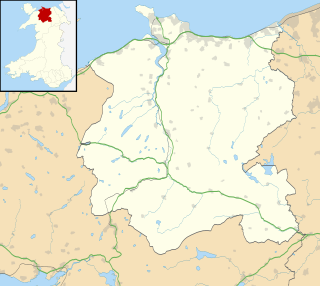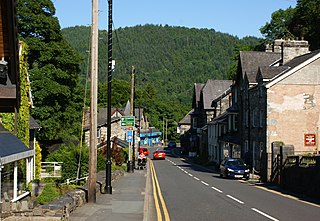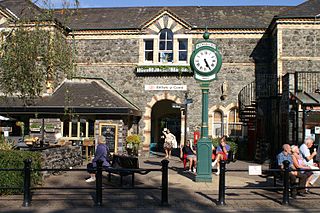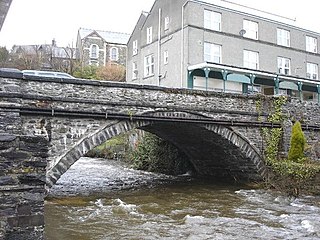History
The Woollen industry in Wales was once an important part of the Welsh economy. Originally called the Vale of Conwy Woollen Mill, the mill was built in 1820 higher up than the present mill on the banks of the Afon Crafnant. Thomas Williams purchased the mill in 1859 and expanded the business. Products from the woollen mills were taken to the coast from the quay at Trefiw using the River Conwy.
A 36-foot (11 m) in diameter overshot wheel powered spinning mules and jennies. The yarn was then woven into cloth on hand looms. A smaller 7-foot (2.1 m) wheel powered a fulling mill, which washed the cloth and kneeded it with wooden hammers to thicken and strengthen it. The water wheels were dismantled around 1900 when the first hydroelectric turbine was installed.
Workers at the Trefriw Woollen Mills competed in the 1918 National Eisteddfod of Wales and won prizes for objects such as a sample of fine cream serge, a sample of white baby flannel and two double-size blankets.
Two Pelton wheel turbines made by Boving were installed in a former flour mill in 1942 and 1951 to deliver 60 kW to the mill machinery. The turbines are fed through a 20 inches (510 mm) diameter pipe from a dam built in 1952 0.5 miles (0.80 km) upstream and 125 feet (38 m) higher up. Most of the present machinery was acquired in the 1950s and 1960s. The present main building, with three shallow-sloping roofs, was erected around 1970. Several older mill buildings are behind the main building, accessible from the mill yard.

Snowdonia is a mountainous region in northwestern Wales and a national park of 823 square miles (2,130 km2) in area. It was the first to be designated of the three national parks in Wales, in 1951.

Conwy County Borough is a county borough in the north-west of Wales. It borders Gwynedd to the west and south, and Denbighshire to the east. The county borough is home to the major settlements of Abergele, Betws-y-Coed, Colwyn Bay, Conwy, Llandudno, Llandudno Junction, Llanfairfechan, Llanrwst, and Penmaenmawr.

Betws-y-coed is a village and community in the Conwy valley in Conwy County Borough, Wales, located in the historic county of Caernarfonshire, right on the boundary with Denbighshire, in the Gwydir Forest. It is now a very popular visitor destination in the Snowdonia National Park.

Llanrwst is a market town and community on the A470 road and the River Conwy, in Conwy County Borough, Wales, and the historic county of Denbighshire. It developed round the wool trade and became known also for the making of harps and clocks. Today, less than a mile from the edge of Snowdonia, its main pursuit is tourism. Notable buildings include almshouses, two 17th-century chapels, and the Parish Church of St Grwst, which holds a stone coffin of Llywelyn the Great. The 2011 census gave it a population of 3,323.

Trefriw is a village and community in Conwy County Borough, Wales. It lies on the river Crafnant in North Wales, a few miles south of the site of the Roman fort of Canovium, sited at Caerhun. At the last three censuses the population of the community has been recorded as 842 in 1999, 915 in 2001, and 783 in 2011.

Flannel is a soft woven fabric, of various fineness. Flannel was originally made from carded wool or worsted yarn, but is now often made from either wool, cotton, or synthetic fiber. Flannel is commonly used to make tartan clothing, blankets, bed sheets, and sleepwear.

The River Conwy is a river in north Wales. From its source to its discharge in Conwy Bay it is 55 kilometres (34 mi) long and drains an area of 678 square km. "Conwy" was formerly Anglicised as "Conway."

Llanbedr-y-Cennin is a small village in Conwy county borough, Wales, in the community of Caerhun.

Betws-y-Coed railway station is a railway station on the Conwy Valley Line from Llandudno Junction to Blaenau Ffestiniog, Wales. It is situated 15+1⁄2 miles (24.9 km) south of Llandudno Junction.

Penmachno is a village in the isolated upland Machno valley, 4 miles (6 km) south of Betws-y-Coed in the county of Conwy, North Wales. The B4406 road runs through part of the village. The village is at the confluence of the Glasgwm and Machno rivers. It has a five-arched, stone bridge dating from 1785. The village has been referred to as Pennant Machno, Llandudclyd and Llan dutchyd in historical sources.

The Afon Crafnant is a tributary of the River Conwy, which is the main river of the Conwy valley in north-west Wales.

The River Geirionydd is a river in Snowdonia, North Wales. It is a tributary of the River Crafnant, which flows over the Fairy Falls waterfall in Trefriw, and thence on into the River Conwy, which is the main river of the Conwy valley.

Aberconwy is a constituency of the Senedd. First created for the former Assembly's 2007 election. It elects one Member of the Senedd by the first past the post method of election. It is one of nine constituencies in the North Wales electoral region, which elects four additional members, in addition to nine constituency members, to produce a degree of proportional representation for the region as a whole.

The National Wool Museum, located in Drefach Felindre, Llandysul, Carmarthenshire is part of Amgueddfa Cymru – National Museum Wales.

Bro Machno is a community in Conwy County Borough, in Wales, formed from the former civil parish of Penmachno. It covers the Penmachno Valley, through which runs the Afon Machno, and includes the villages of Penmachno and Cwm Penmachno. To the south west borders Gwynedd, and is located 4.8 miles (7.7 km) south of Betws-y-Coed, 21.8 miles (35.1 km) north west of Corwen, and 19.4 miles (31.2 km) south of Conwy. The whole of the community is within the Snowdonia national park, while much of it forms part of Gwydir Forest. According to the 2011 census, the population of the Bro Machno Parish was 617, of whom 342 (55%) were able to speak Welsh and 214 (34%) had no skills in Welsh.

Melin Tregwynt is a woollen mill in the hamlet of Tregwynt in the parish of Granston, Pembrokeshire, Wales. A mill has stood on this site since 1819 taking fleeces from the sheep farms of the area, carding and spinning them into woollen yarn and then weaving the yarn into cloth and blankets. Today, the mill makes a line of upmarket blankets, cushions, clothing, and accessories.

The woollen industry in Wales was at times the country's most important industry, though it often struggled to compete with the better-funded woollen mills in the north of England, and almost disappeared during the 20th century. There is continued demand for quality Welsh woollen products.

Solva Woollen Mill is a woollen mill in the village of Middle Mill, about one mile from Solva, Pembrokeshire, Wales, that has been in operation since 1907.

Rock Mill Llandysul, in Capel Dewi, Llandysul, Ceredigion, is the last woollen mill in Wales to be powered by a water wheel.

Cambrian Woollen Mill, just north of Llanwrtyd Wells, Powys, is one of the few remaining operational woollen mills in Wales. It is known for its line of Welsh tartans. The building dates to 1820.






















